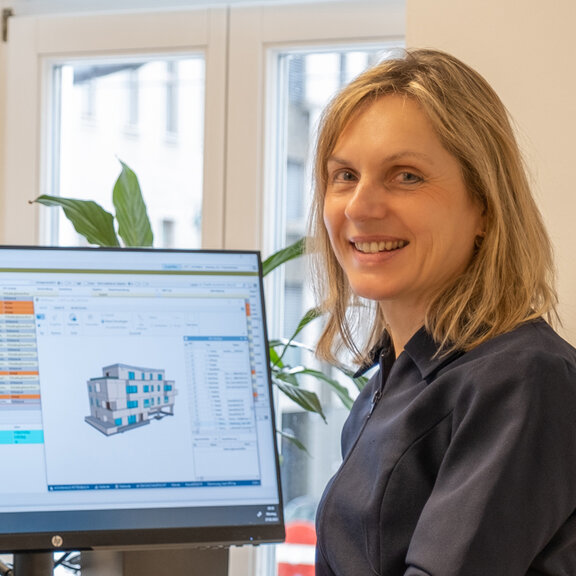BIM interview series part 1
BIM standards are required to ensure that building information modelling (BIM) works seamlessly. We asked experts from Working Group 011 09 "Technical drawing and documentation in the construction industry" what the benefits to users are.
Standards for building information modelling (BIM) create the basis for uniform data structures and a common data environment. There are centralised BIM standards at a national, European and international level:
- ÖNORM A 6241 series
- ÖNORM A 2063 series
- ÖNORM EN ISO 23386 as an internationally valid basis
We asked the experts from Working Group 011 09 "Technical drawing and documentation in the construction industry" what benefits standards offer to BIM users and what prospects they open up. The discussion was held with:
- Azra Dudakovic, BIM Expert and CEO, SIDE GmbH
- Monika Ilg, Managing Director, ib-data GmbH
- Peter Kompolschek, Managing Director, Kompolschek Architecture Office | Chair of Committee 011 "General building construction"
- Stefan Pölzl, BIM and IT Coordinator, ASFINAG Bau Management GmbH
What benefits do BIM standards offer to users?
Austrian Standards: What benefits do standards offer to BIM users in practice?
Peter Kompolschek: There are standard sizes for paper. The benefits of this are obvious in that consumers can rely on A4 sheets of paper always being the same size and the paper being compatible with the printer, for example. BIM is similar.
If the data structures or data requirements are standardised, cooperating is easier and more efficient. BIM is property-oriented and extremely close to reality – we refer to it as a digital twin. Strong, sophisticated standardisation in the background is a key basis for ensuring that all process participants can generate the right data automatically. A common data environment (CDE) is also required to exchange data. It is important for the process that the data is available to the entire team at the same time – depending on the team members' authorisations of course.
Monika Ilg: The standards ensure that the quality of the data is assured. The performance specification defines which properties always have to be stored in the BIM model in order that you can generate specifications, calculate prices and, of course, generate invoices. Properties were created in groups and standards established for this purpose.
Stefan Pölzl: For us at ASFINAG, it is important that our tendering processes are product and software-neutral. The open BIM standard and its further evolution is of utmost importance to us as a public body.
Azra Dudakovic: I remember the time before BIM. Everyone had to do their own thing for each project. Now we have structured data and information management processes with rules of play which are defined in standards.
Where is the journey with BIM standards taking us?
Austrian Standards: A lot has already happened in the past. In what areas is there the need to further develop the BIM standards?
Azra Dudakovic: The processes are already fairly well standardised and are further developed on an ongoing basis. We still need more definitions in the data structure of the open standards, for example how we label various elements or attributes in order to be able to share them with participants. A lot of work is still required here.
Peter Kompolschek: The requirements of a standardisation framework are derived from real-life experience. Infrastructure operators and the like are extremely interested in – and have put a lot of pressure on – ensuring that there are structures for their trades. A couple of years ago, BIM was still exclusively intended for building construction. However, the pressure from the market has become so great that all infrastructure projects can now be mapped – whether it's a bridge, a section of a motorway or a road junction.
The standards are also important for digital building applications which will probably subsequently be checked automatically as far as possible. This means that a huge amount of usable information has to be provided for this.
Who are the international pioneers at BIM?
Austrian Standards: Where does building information modelling stand in an international context?
Stefan Pölzl: Building information modelling is very well established in the field of infrastructure in Germany and Switzerland, as the use of BIM is legally enshrined. There are often similar problems internationally in the infrastructure, for example when integrating the data structure in the internal systems. Topics such as sustainability and accessibility are being gradually developed and the initial pilot projects for determining limit values, etc. are ongoing.
Azra Dudakovic: When it comes to BIM in Europe, the United Kingdom definitely laid much of the foundations. There has always been the tradition of first planning and then building there, while these phases have somewhat overlapped in Austria.
BIM depends on the user first erecting the building in a virtual environment before starting construction in real life. Everything can be simulated and risk factors can be identified at an early stage in this virtual world. Scandinavian countries are also very advanced when it comes to BIM. Digital building applications have been used in Singapore for years. Almost all buildings are digitally recorded there in some way.
Peter Kompolschek: In Austria, the current government programme specifies that BIM is to be preferred in public procurement. Besides the legislature, these topics are being advanced independently. Many aspects which are so important to us because we are repeatedly forming new teams and because we are always involved in the process to the end as the planner are not necessary in countries such as the United Kingdom, Canada or the USA with their general contractors. A key point to note is that BIM is not restricted to 3D models, but rather it is a comprehensive database.
Monika Ilg: In the United Kingdom, Scandinavia and the USA, the contract is awarded to a general planner or contractor. However we do not necessarily want this for Austria and for the Austrian economy, as there is the risk that SMEs in particular only act as subcontractors.
Austria is therefore extremely well positioned with the standards which we have for BIM. In this respect, I do not think there are very many role models in Europe. Quite the reverse – Austria is a pioneer. The fact that we produce data which we can pass through from the client to invoicing simply cannot be taken for granted. These are currently still individual pilot projects, but they demonstrate the great potential of standardised BIM in a striking manner.
You can find out more about BIM pilot projects and what conclusions can be drawn from them in part 2 of the expert panel.
Is CEO of BIM consulting company SIDE GmbH, where she advises and supports customers when it comes to the strategic and operational implementation of construction information technologies. She started her journey towards digitalising the construction sector at STRABAG AG, where she helped play a part in BIM developments for five years. Before she moved to Vienna, she coordinated research projects at the Institute for Architecture at the University of Sarajevo and also worked in architecture planning.

Ist Geschäftsführerin der ib-data GmbH, Hersteller der ABK-Bausoftware. Seit 2018 ist sie Vorsitzende der Arbeitsgruppe ÖNORM A 2063-1 und 2 und wirkt in weiteren Standardisierungsgremien zu den Themen BIM, Ausschreibung, Kalkulation, Abrechnung und Kostenmanagement mit (ÖNORM B 2061, ÖNORM A 6241-2, ÖNORM B 1801-1).

Diplomingenieur für Architektur an der TU Graz, eigenes Architekturbüro seit 2000, Lehrender an der FH Joanneum für Revitalisierung, Projektmanagement und Lebenszyklus von 2011 bis 2018. Dort Entwicklung eines BIM Curriculums, Diverse Konsulentenaufträge für BIM bezogene Aufgabenstellungen im In- und Ausland. Zahlreiche Wohn- und Gesundheitsbauten, darunter Revitalisierung des ältesten Bauteils des LKH Villach. Seit 2014 European BIM Group – Delegierter Österreichs.

Ist seit Februar 2021 als „Experte BIM und IT-Koordinator“ tätig. Zu seinen Tätigkeiten zählt die Weiterentwicklung der BIM-Agenden, die Betreuung der BIM-Projekte, die Optimierung des Bauprozesses durch Digitalisierungsaspekte und die Schaffung und Bereitstellung von zentralen, vernetzten und durchgängigen Daten in der ASFINAG. Des Weiteren ist er Mitglied in Arbeitskreisen (Austrian Standards, ÖIAV, ÖBV, FSV ...) zu den Themen BIM und Digitalisierung.



